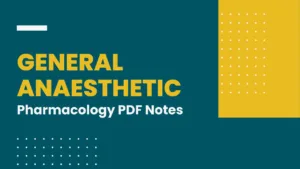General Anaesthetic

Content
General anesthetics
• Non-volatile anesthetics
• Pharmacological actions of thiopental
• Ketamine
• Neuroleptanalgesia
Intended Learning Outcomes
At the end of this lecture, student will be able to
• Give examples for non-volatile anaesthetics/intravenous anaesthetics
• Explain the pharmacological actions of thiopental
• List the uses of ketamine
• Describe neuroleptanalgesis
General Anaesthetics
Intravenous anesthetics
• These are inducing agents- because of rapidity of onset of action
• Maintained by inhalation agent
• Fast inducers- thiopental, methohexital, etomidate and propofol
Thiopentone sodium
• Ultra short acting barbiturates
• Induction very quick and pleasant- recovery also rapid
• Rapidly cross BBB and diffuse rapidly out of brain and redistributed
• Short acting
• Poor analgesic
![]() Reduce cerebral metabolic rate of O2 consumption –> Cerebral vasoconstriction –> Reduce intracranial pressure and blood flow
Reduce cerebral metabolic rate of O2 consumption –> Cerebral vasoconstriction –> Reduce intracranial pressure and blood flow
Adverse effects
• Laryngospasm– prevent by atropine and succinylcholine
• Postoperative Pain – adequate analgesia should be provided
• pH is 11- local tissue damage(extravasate)
Uses
• Anticonvulsant in emergency treatment of intractable seizures
• Suitable
drug for patients with cerebral oedema and brain tumor
ADME
• High lipid solubility
• Very short duration of action
• Rapidly metabolized by liver
• With successive doses body fat depots get saturated
• Slow release into plasma – prolonged recovery
• Readily cross placental barrier
Ketamine- Dissociative anaesthesia
• Characterised by a feeling of dissociation from surrounding. Profound analgesia, immobility and amnesia
• Primary site of action- cortex and limbic system (not RAS)
• Block the action of glutamate at NMDA receptor
• Dose: IM 5-10 mg/kg, IV 1-2 mg/kg
• 0.1– 0.25 mg/kg IV complete analgesia
• Increases BP, HR, CO – Avoided in IHD patients
• Suitable for patients of hypovolemic shock
Disadvantages of Ketamine
• Causes Nystagmus, involuntary movements
• May cause delirium, hallucinations, colourful dreams
• Salivation may be troublesome
• Muscle relaxation – inadequate
• Increases i.o.t and intracranial pressure
• Drug of abuse
• Used for short lasting procedure:
• Cardiac catheterization, bronchoscopy, dressing of burns, forceps delivery, teeth extraction, manual removal of placenta, dental work
• Not used in:
• Heart disease, abdominal surgery, thyrotoxic patients, pregnant women at term, operation of eye, psychiatric disorders
Neuroleptanalgesia
• Combines the use of a neuroleptic drug with an opioid analgesic drug
• Differs from the classical general anesthesia
• Subject is conscious and able to cooperate during operative procedure
• Most favoured combination: Neuroleptic droperidol and analgesic drug fentanyl
Preanesthetic Medication
• To reduce anxiety and apprehension
• To obtain additive or synergistic effect – induction smooth and rapid
• To counteract certain adverse effects
• To relieve pre and post-operative pain
• To suppress respiratory secretion
• To reduce reflex excitability
1. Opioid analgesics
2. Sedative and tranqullisers: Bzds like diazepam/lorazepam: -smooth induction, loss of recall of perioperative events
3. Antimuscarinic drugs: Atropine/hyoscine and glycopyrrolate to reduce salivary and bronchial secretion
4. Antiemetics: Metoclopromide reduce post-operative vomiting, reduce chances of reflux and aspiration (by increase gastric emptying)
5. H2 Blockers/PPIs: reduce the risk of gastric regurgitation and aspirational pneumonia
Drugs Administered During Anesthesia
• Skeletal muscle relaxant
• Very short acting ganglionic blocker – to produce controlled hypotension
• Drugs to counter the anesthetic complication:
– Vasopressin – to correct hypotension
– Antiarrythmics
– Anticonvulsants
Summary
• Thiopental has high lipid solubility and thereby very short duration of action
• It is used in induction of anesthesia in short duration for fracture reduction, dilatation and curettage, laryngoscopy, bronchoscopy
• Ketamine is antagonist at NMDA receptor of cerebral cortex (limbic system)
• Following single dose produces dissociative anesthesia
For Detailed PDF Notes Click on Download Button
